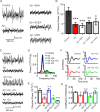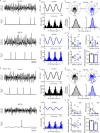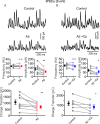TrpV1 receptor activation rescues neuronal function and network gamma oscillations from Aβ-induced impairment in mouse hippocampus in vitro
- PMID: 30417826
- PMCID: PMC6281315
- DOI: 10.7554/eLife.37703
TrpV1 receptor activation rescues neuronal function and network gamma oscillations from Aβ-induced impairment in mouse hippocampus in vitro
Abstract
Amyloid-β peptide (Aβ) forms plaques in Alzheimer's disease (AD) and is responsible for early cognitive deficits in AD patients. Advancing cognitive decline is accompanied by progressive impairment of cognition-relevant EEG patterns such as gamma oscillations. The endocannabinoid anandamide, a TrpV1-receptor agonist, reverses hippocampal damage and memory impairment in rodents and protects neurons from Aβ-induced cytotoxic effects. Here, we investigate a restorative role of TrpV1-receptor activation against Aβ-induced degradation of hippocampal neuron function and gamma oscillations. We found that the TrpV1-receptor agonist capsaicin rescues Aβ-induced degradation of hippocampal gamma oscillations by reversing both the desynchronization of AP firing in CA3 pyramidal cells and the shift in excitatory/inhibitory current balance. This rescue effect is TrpV1-receptor-dependent since it was absent in TrpV1 knockout mice or in the presence of the TrpV1-receptor antagonist capsazepine. Our findings provide novel insight into the network mechanisms underlying cognitive decline in AD and suggest TrpV1 activation as a novel therapeutic target.
Keywords: Alzheimer Disease; TrpV1 receptor; amyloid-beta; gamma oscillations; hippocampus; mouse; neuronal network; neuroscience.
© 2018, Balleza-Tapia et al.
Conflict of interest statement
HB, SC, YA, PD, DP, GC, JJ, AF No competing interests declared
Figures









References
-
- Benito C, Tolón RM, Castillo AI, Ruiz-Valdepeñas L, Martínez-Orgado JA, Fernández-Sánchez FJ, Vázquez C, Cravatt BF, Romero J. β-Amyloid exacerbates inflammation in astrocytes lacking fatty acid amide hydrolase through a mechanism involving PPAR-α, PPAR-γ and TRPV1, but not CB₁ or CB₂ receptors. British Journal of Pharmacology. 2012;166:1474–1489. doi: 10.1111/j.1476-5381.2012.01889.x. - DOI - PMC - PubMed
Publication types
MeSH terms
Substances
LinkOut - more resources
Full Text Sources
Other Literature Sources
Molecular Biology Databases
Miscellaneous

